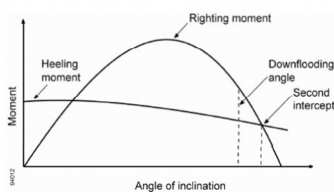

< Previous | Contents | Next >
Section 2 Righting Moment and Heeling Moment Curves
201. General
1. Curves of righting moments and of wind heeling moments similar to Fig 4.1 with supporting cal- culations should be prepared covering the full range of operating draughts, including those in transit conditions, taking into account the maximum loading of materials in the most unfavourable position applicable. The righting moment curves and wind heeling moment curves should be related to the most critical axes. Account should be taken of the free surface of liquids in tanks.
2. Where equipment is of such a nature that it can be lowered and stowed, additional wind heeling moment curves may be necessary and such data should clearly indicate the position of such equipment. Provisions regarding the lowering and effective stowage of such equipment should be in- cluded in the operating manual.
3. The curves of wind heeling moments should be drawn for wind forces calculated by the following formula:
![]()
the wind force (N).
: the shape coefficient depending on the shape of the structural member exposed to the wind (see table 4.1)
the height coefficient depending on the height above sea level of the structural member ex- posed to wind (see table 4.2)
: the air mass density (1.222 kg m )
: Design wind velocity specified in Par 4 (m sec).
: the projected area of all exposed surfaces in either the upright or the (m ).

Fig 4.1 Righting moment and heeling moment curves
Table 4.1 Shape Coefficient
heeled condition
Shape |
|
Spherical | 0.4 |
Cylindrical | 0.5 |
Large flat surface (hull, deckhouse, smooth under-deck areas) | 1.0 |
Drilling derrick | 1.25 |
Wires | 1.2 |
Exposed beams and girders under deck | 1.3 |
Small parts | 1.4 |
Isolated shapes (crane, beam, etc.) | 1.5 |
Clustered deckhouses or similar structures | 1.1 |
![]()
Table 4.2 Height Coefficient
Height (m ) |
| |
Over | Not Exceeding | |
15.3 | 15.3 | 1.00 |
30.5 | 1.10 | |
30.5 | 46.0 | 1.20 |
46.0 | 61.0 | 1.30 |
61.0 | 76.0 | 1.37 |
76.0 | 91.5 | 1.43 |
91.5 | 106.5 | 1.48 |
106.5 | 122.0 | 1.52 |
122.0 | 137.0 | 1.56 |
137.0 | 152.5 | 1.60 |
152.5 | 167.5 | 1.63 |
167.5 | 183.0 | 1.67 |
183.0 | 198.0 | 1.70 |
198.0 | 213.5 | 1.72 |
213.5 | 228.5 | 1.75 |
228.5 | 244.0 | 1.77 |
244.0 | 259.0 | 1.79 |
259.0 | 1.80 | |
4. Wind forces should be considered from any direction velocity should be as follows:
relative to the unit and the value of the wind
(1) In general a minimum wind velocity of 36 m/s (70 knots) for offshore service should be used for normal operating conditions and a minimum wind velocity of 51.5 m/s (100 knots) should be used for the severe storm conditions.
(2) Where a unit is to be limited in operation to sheltered locations (protected inland waters such as lakes, bays, swamps, rivers, etc.) consideration should be given to a reduced wind velocity of not less than 25.8 m/s (50 knots) for normal operating conditions.
5. In calculating the projected areas to the vertical plane, the area of surfaces exposed to wind due to heel or trim, such as under-deck surfaces, etc., should be included using the appropriate shape factor. Open truss work may be approximated by taking 30% of the projected block area of both the front and back section, i.e. 60% of the projected area of one side.
6. In calculating the wind heeling moments, the lever of the wind overturning force should be taken vertically from the centre of pressure of all surfaces exposed to the wind to the centre of lateral resistance of the underwater body of the unit. The unit is to be assumed floating free of mooring restraint.
7. The wind heeling moment curve should be calculated for a sufficient number of heel angles to de- fine the curve. For ship-shaped hulls the curve may be assumed to vary as the cosine function of vessel heel.
8. Wind heeling moments derived from wind tunnel tests on a representative model of the unit may be considered as alternatives to the method given in Par 3 to 7. Such heeling moment determi- nation should include lift and drag effects at various applicable heel angles.